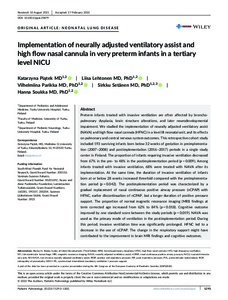Implementation of neurally adjusted ventilatory assist and high flow nasal cannula in very preterm infants in a tertiary level NICU
Lehtonen Liisa; Parikka Vilhelmiina; Piatek Katarzyna; Setänen Sirkku; Soukka Hanna
Implementation of neurally adjusted ventilatory assist and high flow nasal cannula in very preterm infants in a tertiary level NICU
Lehtonen Liisa
Parikka Vilhelmiina
Piatek Katarzyna
Setänen Sirkku
Soukka Hanna
WILEY
Julkaisun pysyvä osoite on:
https://urn.fi/URN:NBN:fi-fe2022081154483
https://urn.fi/URN:NBN:fi-fe2022081154483
Tiivistelmä
Preterm infants treated with invasive ventilation are often affected by bronchopulmonary dysplasia, brain structure alterations, and later neurodevelopmental impairment. We studied the implementation of neurally adjusted ventilatory assist (NAVA) and high flow nasal cannula (HFNC) in a level III neonatal unit, and its effects on pulmonary and central nervous system outcomes. This retrospective cohort study included 193 surviving infants born below 32 weeks of gestation in preimplementation (2007-2008) and postimplementation (2016-2017) periods in a single study center in Finland. The proportion of infants requiring invasive ventilation decreased from 67% in the pre- to 48% in the postimplementation period (p = 0.009). Among infants treated with invasive ventilation, 68% were treated with NAVA after its implementation. At the same time, the duration of invasive ventilation of infants born at or below 28 weeks increased threefold compared with the preimplementation period (p = 0.042). The postimplementation period was characterized by a gradual replacement of nasal continuous positive airway pressure (nCPAP) with HFNC, earlier discontinuation of nCPAP, but a longer duration of positive pressure support. The proportion of normal magnetic resonance imaging (MRI) findings at term corrected age increased from 62% to 84% (p = 0.018). Cognitive outcome improved by one standard score between the study periods (p = 0.019). NAVA was used as the primary mode of ventilation in the postimplementation period. During this period, invasive ventilation time was significantly prolonged. HFNC led to a decrease in the use of nCPAP. The change in the respiratory support might have contributed to the improvement in brain MRI findings and cognitive outcomes.
Kokoelmat
- Rinnakkaistallenteet [19207]
